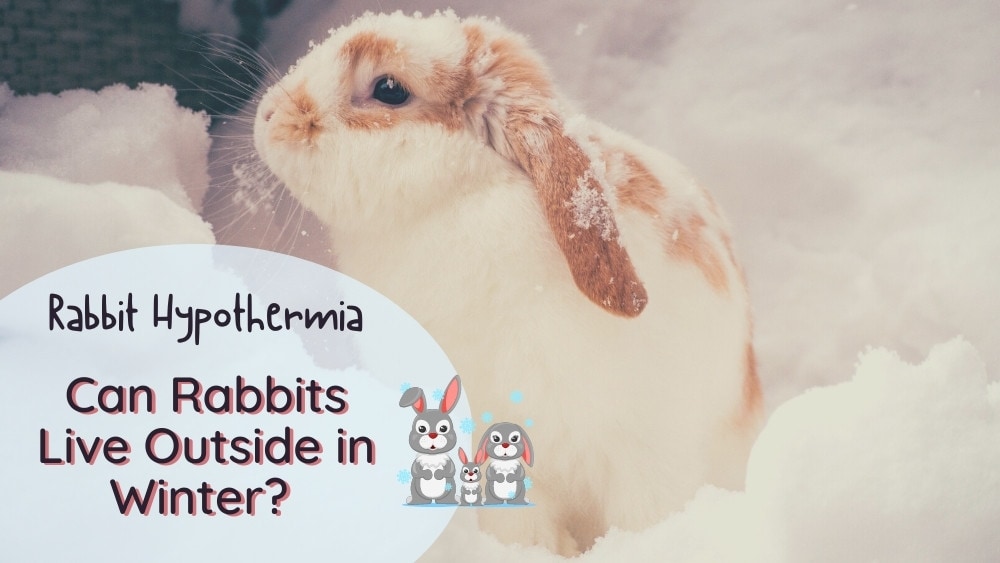When the temperature drops, and there’s snow on the ground, we wear extra layers and tend to stay indoors more to keep warm. But what about rabbits? They can’t wear an extra coat (although the idea is cute).
In my experience, pet rabbits cope pretty well in the cold with some help from their owners. In this article, we’ll look at whether rabbits can live outside in winter and how to keep them warm.
Can Rabbits Stay Outside in Winter?
It’s best for domestic rabbits to live indoors, especially during winter. Bunnies can struggle in extreme temperatures. However, healthy rabbits can live outside during winter as long as you take precautions to keep them comfortable.
How Cold Can Rabbits Tolerate?
Rabbits do best in temperatures between 50° and 68° Fahrenheit (10-20°C). A healthy, young bunny can tolerate colder temperatures of as low as 30° to 20° Fahrenheit (-1° to -6° celsius) provided it has an appropriate shelter and is kept dry.
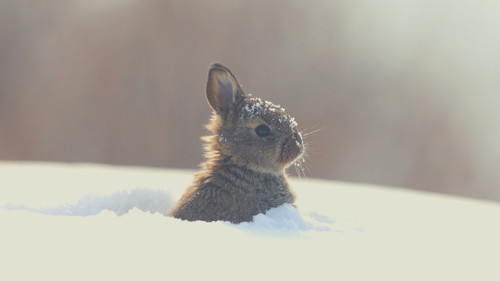
If your rabbit is very young, elderly, or has health issues, it should always be brought indoors in cold weather. Its body won’t cope with winter temperatures.
Do Bunnies Like the Cold?
Rabbits don’t really enjoy any drastic temperature changes. However, they cope better with cold weather than with extreme heat.
Generally, rabbits prefer a consistently comfortable temperature, which is one of the main reasons it’s best to keep them indoors year-round.
Changes in Rabbits During Winter
As the weather changes, you’ll notice that your bunny experiences some changes. These changes occur whether rabbits live indoors or outdoors.
Coat Changes
If you’re a rabbit owner, you’ll know that your bunny starts shedding twice a year. That pesky fur gets all over your house! Rabbits shed their coats in spring, ready for summer. They shed again in the fall to grow nice thick coats to keep them warm in the winter months. It’s just like us putting on our layers!
Appetite Changes
Wild rabbits eat more as colder weather approaches to give them a protective layer of fat. They also need more calories as their little bodies work harder to keep them warm.
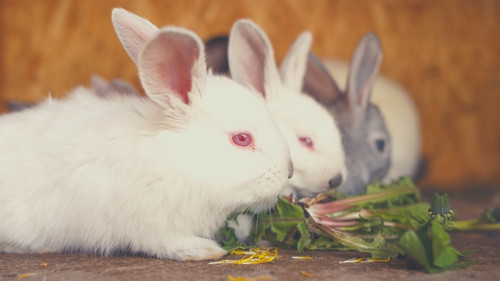
Pet bunnies still have a larger appetite when it’s cold outdoors, especially if they live outside. You’ll likely see your rabbit eating a lot more hay and perhaps even begging for extra food!
Behavioral Changes
Sleeping Positions
Something I noticed with my bunny, even though he was an indoor rabbit, is that his sleeping positions changed in winter. Instead of flopping onto his side or lying sprawled out, he would lie on his front in a ‘loaf’ position.
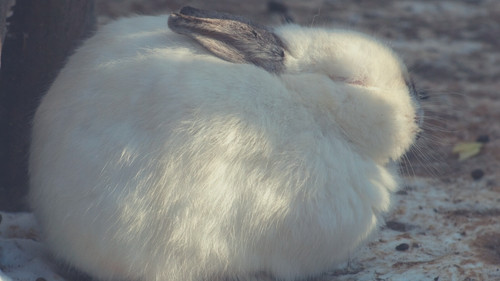
Rabbit lovers call it a loaf because bunnies tuck their little feet in and look like a cute, fluffy loaf of bread! This position lets them hold onto more body heat because their limbs and stomach aren’t exposed.
Playtime
Lots of bunnies become more playful as the temperature drops. They enjoy the cool weather (although not when it gets too cold). Moving around more also helps to keep their body temperature up.
You might see your rabbit running around, digging, chewing, and binkying more often. Binkying is a playful jump that rabbits do to show they’re happy!
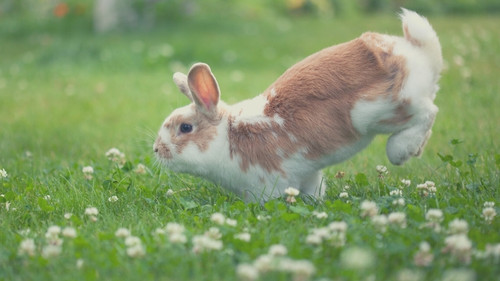
Be sure to rabbit-proof your home, especially if your bunny usually lives outdoors. That way, you can relax and enjoy playtime with your best friend!
How to Keep Rabbits Warm in Winter
The best way to keep your rabbit warm in the winter months is to bring it indoors if it usually lives outside. I highly recommend keeping your bunny inside year-round if you can. They’re amazing, loving house pets and are so much fun to have in your home. Having a house rabbit was one of the greatest privileges of my life.
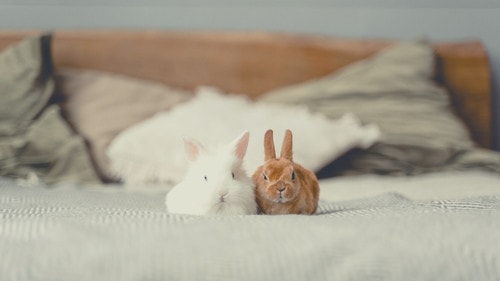
If you bring your rabbit inside, try to do so a few weeks before the temperature drops. If you move your bunny inside and it’s been out in freezing temperatures, the drastic change can be too much for it.
Remember that ideal 50° to 68° Fahrenheit we mentioned earlier? Once your rabbit is inside, try to keep your home at a steady temperature within this range.
Keep a close eye on your rabbit on cold days, even if they’re inside. I suggest checking on your bunny as often as possible so you can notice early signs of it getting too cold.
How to Keep Rabbits Outside in Winter
If you’re unable to bring your rabbit indoors, you can still keep it warm, but you’ll need to put some extra effort in. It’s best to prepare for the colder weather in advance.
Shed or Garage
The next best option to bringing your bunny inside is to move it into a shed or unused garage over winter (if you have one).
If you don’t have a shed but are interested in that option, there are plenty of reasonably affordable sheds you can buy. This Devoko Outdoor Storage Shed is budget-friendly, while this KETER Manor shed is a bit more of an investment.

Of course, you need to ensure your rabbit’s hutch will fit inside the shed. Ideally, the shed would be big enough to have a run for your bunny too. Your rabbit will still need plenty of exercise!
Check Their Home
Make sure your bunny’s home is:
- Waterproof
- Free of cold drafts
- Dry and free of damp
- Well ventilated
- Escape-proof
- Safe from predators
It’s best to check this anyway regularly, but it’s especially important in winter. Give yourself plenty of time to do repairs before those cold temperatures set in.
Add Insulation
Adding insulation will keep your bunny nice and warm. You can add cardboard to the walls of the outdoor rabbit hutch to provide an extra layer of protection. It’s an affordable option if you’re on a budget.
If you’re handy with DIY, you can create a cavity wall in your rabbit’s hutch. Use plywood to create a second wall and floor. Leave a gap between the plywood and the wall of the hutch, which you can then fill with shop-bought insulation. This is an excellent option because it will last long-term.
A tip I love from Rabbit Welfare and Fund (RWAF) veterinary surgeon Richard Saunders is to insulate the hutch from the outside. He recommends covering the outside of the hutch with silver-backed mats to keep your rabbit’s body heat inside their home.
You can buy a hutch cover to add an extra layer. These covers are waterproof and usually have a transparent section at the front so your bunny can still see what’s happening outside. This UCARE Hutch Cover is a good example.

In very low temperatures, you can layer an old blanket or duvet around the hutch for extra warmth. Combine some of these insulation ideas, and your rabbit will be toasty warm!
Block Drafts
If there are any gaps, fill them in to prevent drafts. Make sure you use a pet-safe sealant or filler.
Raise Their Hutch
A lot of hutches have come raised off the ground. If your rabbit’s hutch is sitting on the ground, raise it for the winter. This prevents the hutch’s base from getting damp (which can lead to rotting). It also stops any snow, ice, and frost from getting into your bunny’s home.
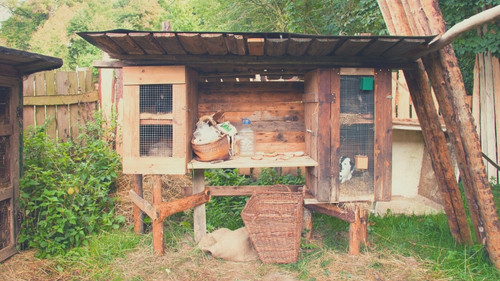
You can add some sturdy wooden legs if you’re handy with that sort of thing. Or you can simply use some bricks or even an old piece of furniture as a stand!
Sheltered Position
The front of your rabbit’s hutch will be more open for ventilation. Of course, this lets in wind and cold air. Face the exposed side of the hutch away from the direction of the strongest winds.
Provide a Heater
If your bunny is in a shed or unused garage, you could use a portable heater or another heat source to help them stay warm. Just ensure it’s not close enough for your rabbit to chew on the wires or get overheated.
More Sleeping Areas
Make sure your rabbit has an enclosed sleeping area where it can get cozy. Most hutches have a more sheltered, warmer area, but you can also provide extra huts and hides. If you have multiple rabbits, make sure there’s a separate space for each bunny (they might not want to snuggle up all the time).
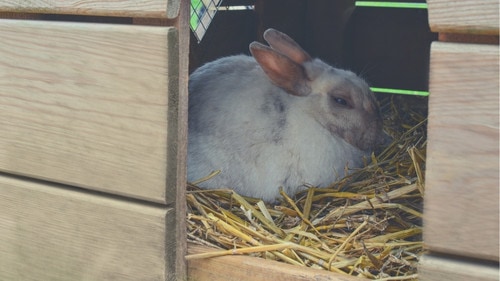
Provide Extra Bedding
When we’re cold at night, we often add an extra blanket! You can do the same for your rabbit by providing more bedding. Add plenty of extra hay. This will also help with your rabbit’s need to eat more, as we discussed earlier.
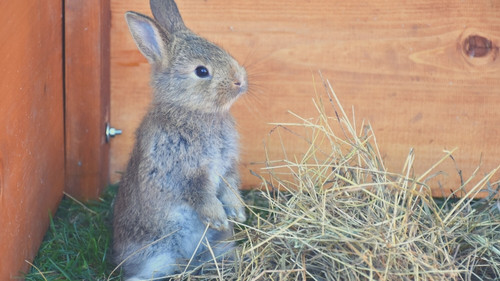
Offer a Heating Pad or Bottle
When I’m cold, I love a microwavable heating pad or a hot water bottle. Bunnies can have heating pads too!
I highly recommend the Snuggle Safe Microwave Heating Pad. I’ve used these pads in catteries, for outdoor rabbits and guinea pigs I’ve worked with, and even in kennels to keep the dogs warm.
Prevent Their Water from Freezing
In winter, your rabbit’s water can be prone to freezing. If you usually use a water bottle, switch to a bowl during winter. Water in bowls is less likely to freeze because it’s inside your bunny’s hutch rather than sitting against the outside. Either way, check their water multiple times daily to ensure it’s not frozen.
Keep Them Clean and Dry
When rabbits get wet and it’s cold, they’re at the biggest risk for hypothermia. Double-check the roof of your rabbit’s hutch to ensure it’s secure and won’t let any water in. The outside of the hutch will need to be treated with a pet-safe wood preservative to keep it waterproof. You should also clean your rabbit’s hutch as regularly as possible to get rid of any sodden bedding.
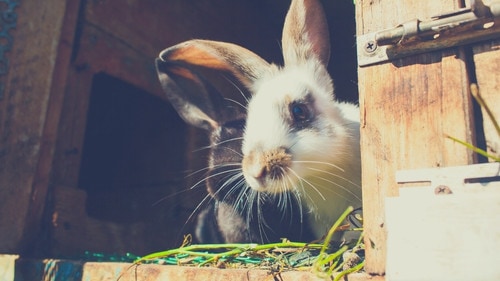
Allow Exercise Indoors
Your bunny will still need lots of exercise outside of its enclosure. If it’s freezing outside, you’ll need to bring your rabbit inside to run around. If you do use an outdoor run, dry your rabbit off thoroughly before putting it back in its hutch.
Check Them Regularly
Check on your rabbit as much as possible. I recommend checking at least a few times a day. Look for any signs of ill health so you can catch issues early.
How Do I Know if My Rabbit is Warm Enough?
So, when you’re checking on your bunny, how do you tell if it’s too cold? Any change in behavior, appetite, or drinking habits is worth investigating further. If you notice any of the problems below, take your furbaby to the vet.
Symptoms of Hypothermia
A rabbit’s body temperature can drop to dangerous levels if gets too cold, especially if it also has wet fur. A pet rabbit can develop hypothermia, just like humans.
Signs of hypothermia in rabbits include:
- Moving around less
- Moving very slowly
- Ears and feet that feel cold when touched
- Lack of response when you talk to them or pet them
- Weak heartbeat
- Shallow breathing
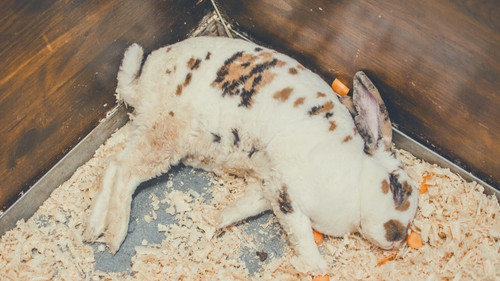
Symptoms of Frostbite
Frostbite most commonly occurs on a rabbit’s feet or ears in extreme cold. If your pet rabbit has frostbite, their ears and feet will turn bright red and then very pale.
Symptoms of Snuffles
Snuffles sound cute, but it’s actually quite serious! It’s similar to a human cold or flu but can be fatal if not treated quickly.
Symptoms of snuffles include:
- Watery eyes
- Runny and wet nose
- Sneezing
- Breathing issues
- Sores or wetness around the eyes, nose, or mouth
- Loss of appetite
- Lethargy
Wild Rabbits in Winter
You might be wondering; surely wild rabbits are fine in winter, so how come pet rabbits need so much help? Well, wild bunnies live in complex underground warrens. The warrens protect them from the weather. The temperature in a warren tends to stay consistent even in winter. Plus, there are lots of other bunnies around to keep them warm!
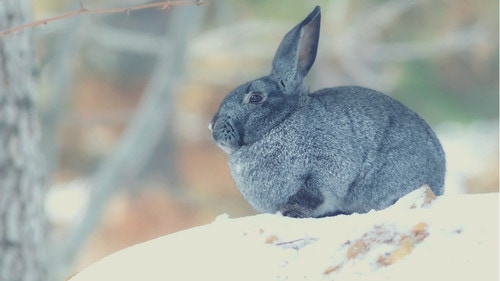
Pet bunnies don’t have warrens, so we have to provide a suitable environment for them. They tend not to have as many rabbit friends around, although they do best with at least one other bunny to live with.
Conclusion
It’s better for pet rabbits to live indoors during winter, but it is possible to keep them safe and warm outside. With extra measures like insulation, heating pads, and extra bedding, your best friend can live happily in their outdoor hutch all winter long.
Do you have an outdoor rabbit? What do you do to keep it warm in winter? We’d love to hear your tips in the comments.


